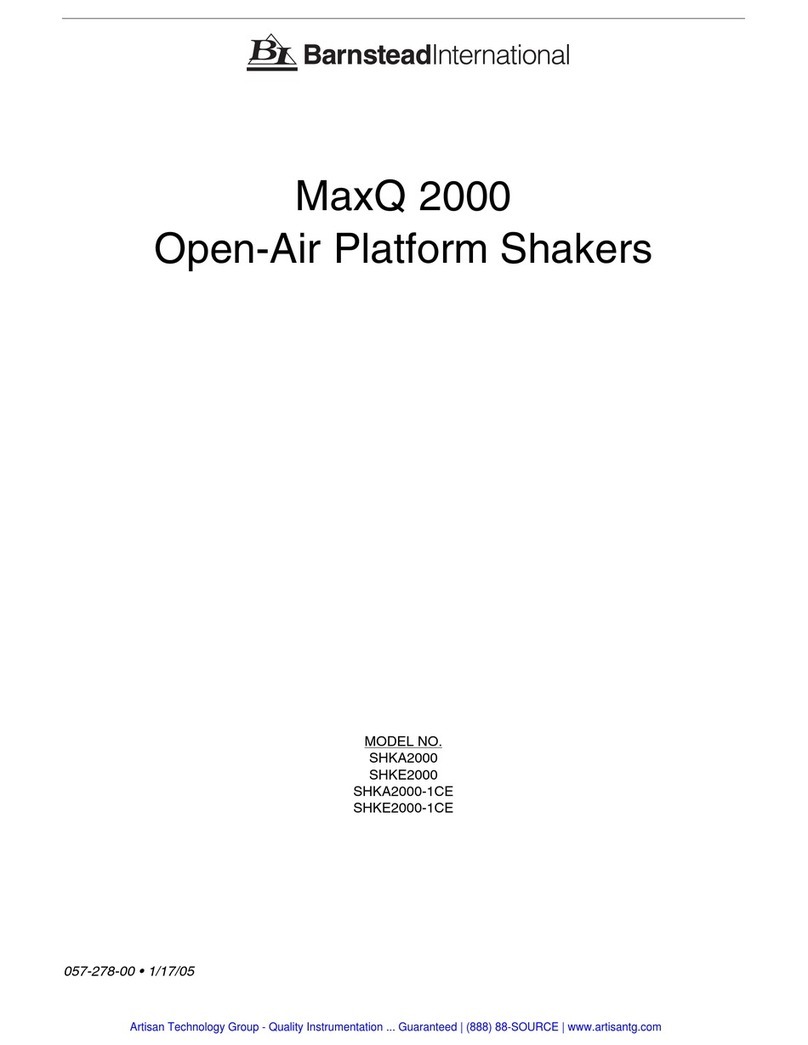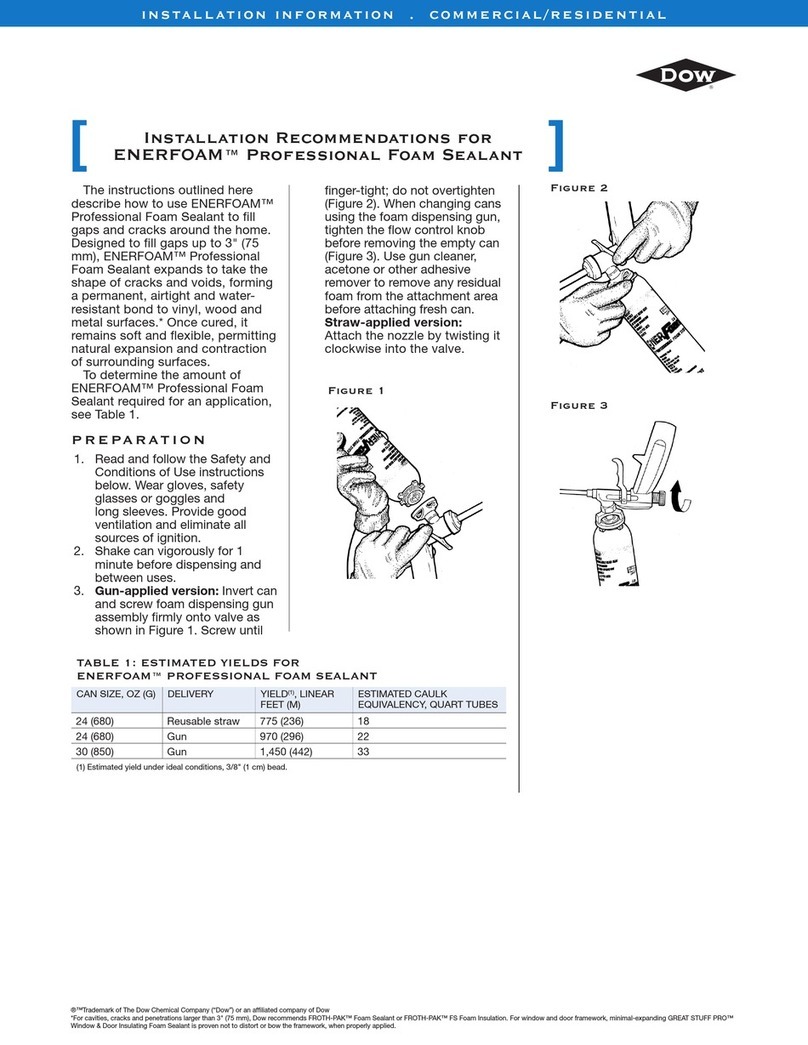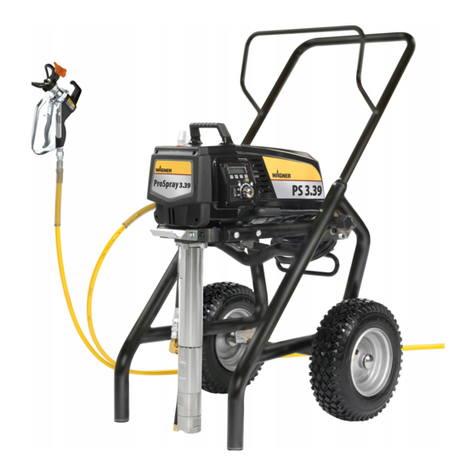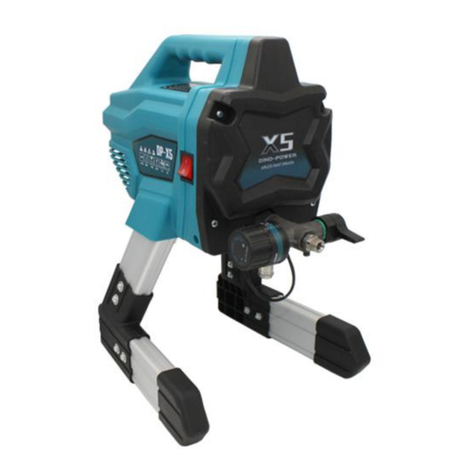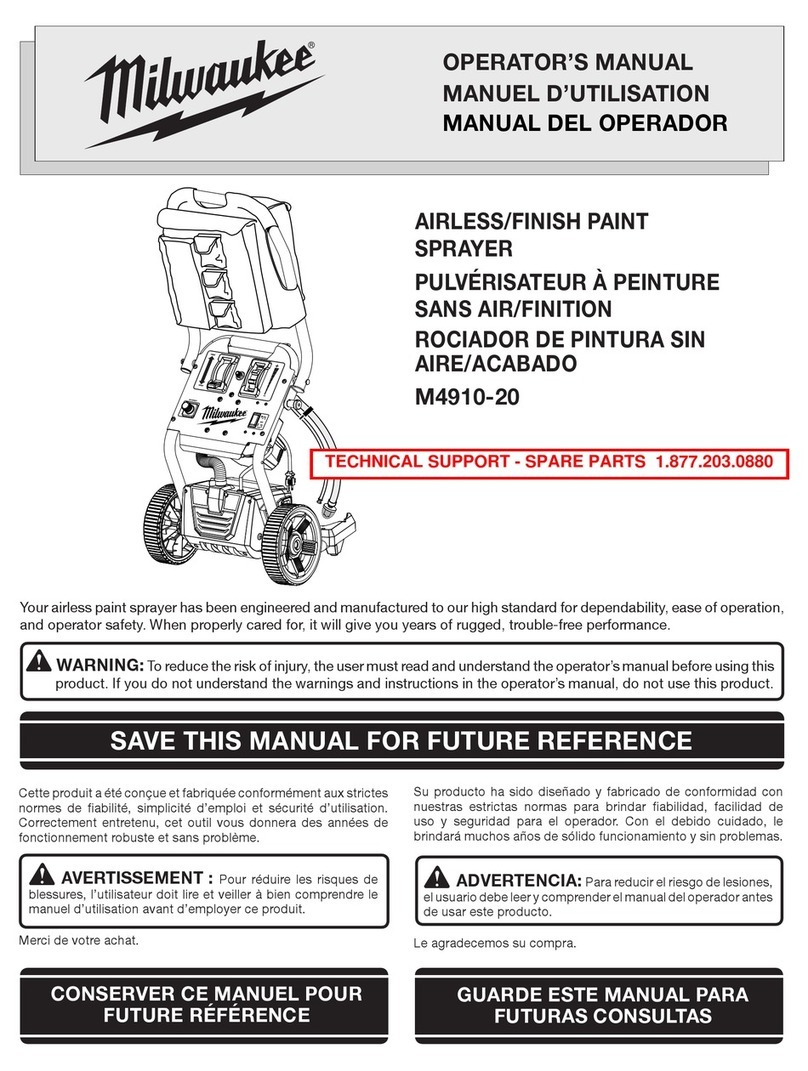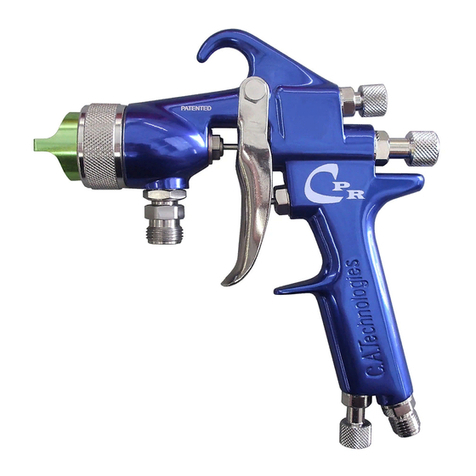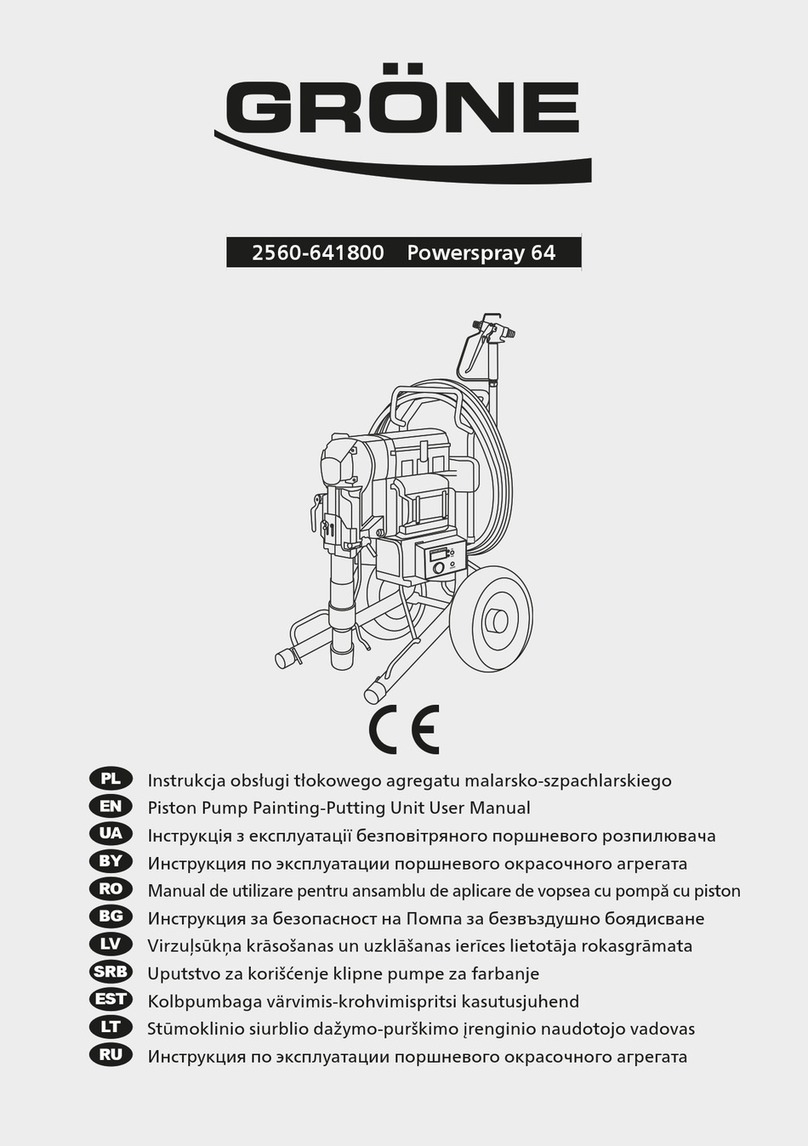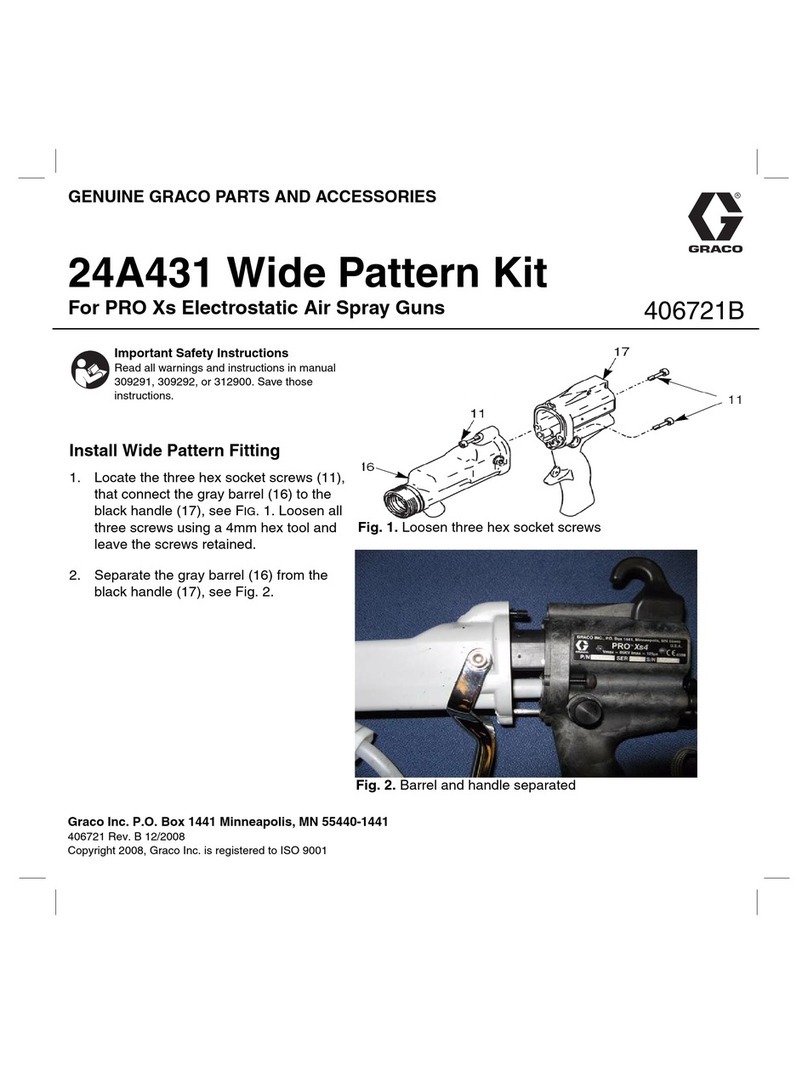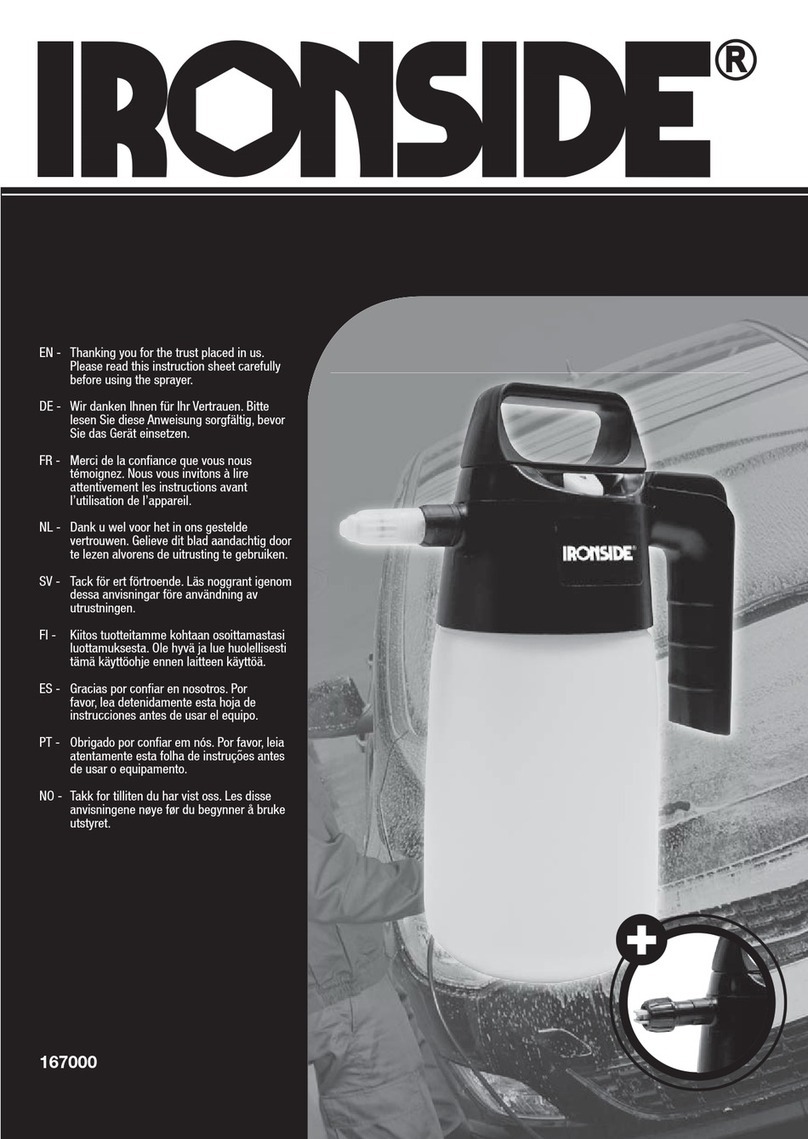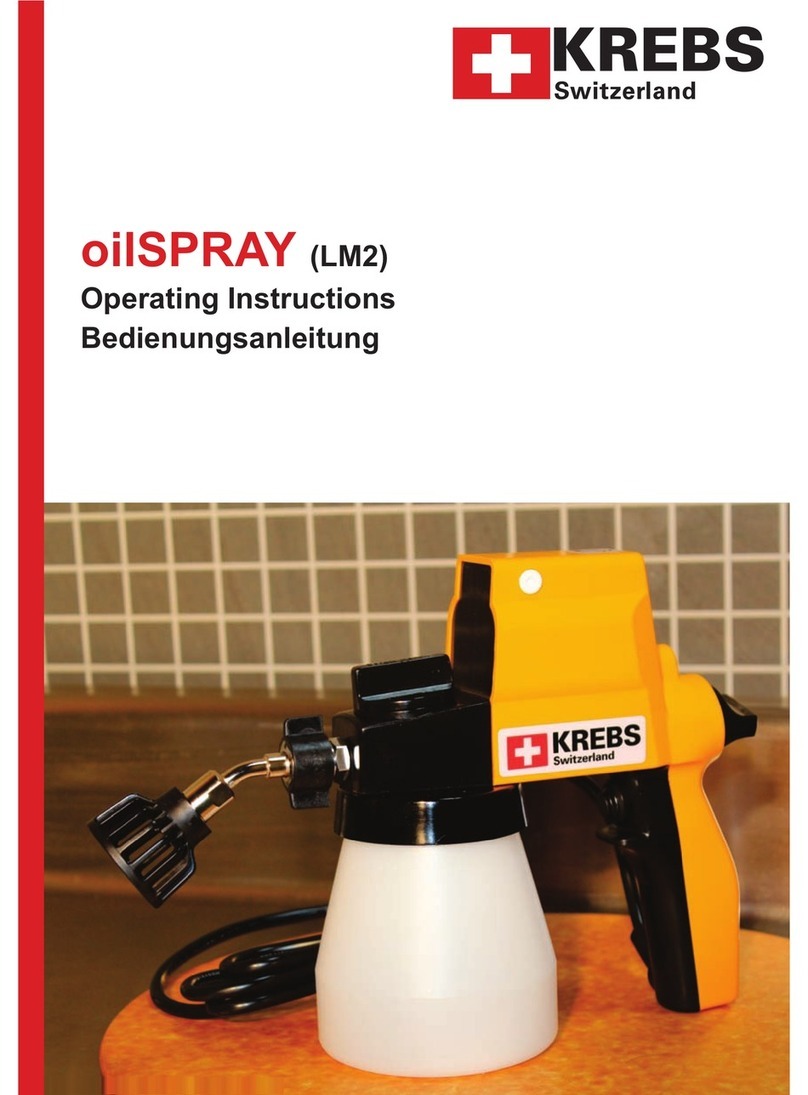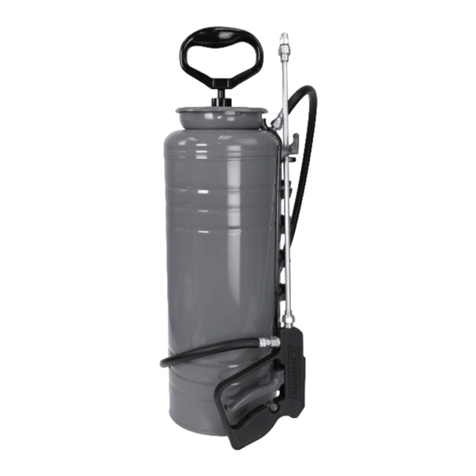Croplands PEGASUS WEED-IT 4000 User manual

1
WEED-IT 4000 - 6000
Part No. BT -OMWEED-A - Rev 1a
Operator’s Manual
2021 - To be read in conjunction with WEED-IT QUADRO Introduction Guide, BT-WEEDQ-INTR-A

BT-OMWEED 012015- Rev 1
Contents
Foreword
Important Information Section 1
Pre-Operation Section 2
Operation Section 3
Calibration Section 4
Lubrication & Maintenance Section 5
Trouble Shooting Section 6
Assembly Drawings & Parts Listings Section 7

BT-OMWEED 012015- Rev 1
Foreword
About This Manual
This manual provides assembly, setting up,
operating and maintenance instructions for
the Croplands Pegasus sprayer.
Some features explained in this manual
may not be installed on your sprayer.
Please pass on this manual with the
sprayer at the time of resale for usage by
the new owner.
Before Operating
Your Sprayer
1 Before attempting to use your
sprayer, make sure you
read all Operator Manuals for this
sprayer:
• This Operator's Manual
• In Field use & Set up Training
- Croplands March 2013
• Boom Parking, Quick Start
Guide, Croplands Part no.
BT-OMWEED_QSG
• User Manual, Model 2013,
and properly understand:
• All Safety Issues.
• Assembly & Installation
instructions.
• Calibration of the sprayer.
• Sprayer Operation.
• Sprayer Maintenance.
Read and understand this Operators’ Manual before
operating the sprayer.
Terminology
These terms/symbols used throughout
this manual:
• NOTE - to convey useful
operating information.
• CAUTION -to highlight potential
injury or machinery
damage.
•WARNING - to stress potential
dangers and the
importance of
personal safety.
Indicates the strong possiblility of severe
personal injury or damage to machinery if
instructions are not followed.
WARNING
Highlights hazards, unsafe/unwise practices
which could cause injury, damage to property,
machinery or loss of crop yield if instructions
are not followed.
CAUTION
Refers to important and useful information which
should not be overlooked.
NOTE
2 Read and follow instructions on
chemical manufacturers' labels.
3 Always wear applicable protective
clothing.
Other manuals for this sprayer are:
• Parts List WEEDit Ag, October
2013
• Service Manual, Model 2013

BT-OMWEED 012015 - Rev 1 1.11.1
Section 1
Important Information
Introduction 1.2
General Specifications 1.3
Shipping Information & Product ID 1.5

1.2 BT-OMWEED 012015 - Rev 1
Important Information
Congratulations on the purchase of your
new Croplands sprayer.
Croplands have been in the business of
building and selling spraying equipment
since 1972. For over 40 years we have
been supplying sprayers to farmers,
contractors, growers and all our customers
involved in growing crops and in the control
of pests and diseases.
Croplands is a wholly owned subsidiary
of Nufarm Ltd, the largest supplier of crop
protection chemicals in Australasia, and
one of the fastest growing global suppliers
world-wide.
At Croplands, we pride ourselves on
our commitment to supplying machinery
that is at the forefront of the industry’s
needs. We believe we can back up our
products and through constant research
and development, bring to you the best
equipment you can find.
Introduction
We welcome any feedback from you about
our equipment.
On this page you will find our contact
details, and locations where our staff can
be reached during business hours.
After hours, you can e-mail us and expect
a reply the following morning.
Please read this manual in its entirety
before you operate your sprayer. This will
ensure you have a trouble-free start up.
We trust you will get years of good use
from your Croplands Sprayer.
Yours sincerely
Sean Mulvaney
General Manager
Contact details:
AUSTRALIA
Croplands Equipment Pty Ltd
ACN 006 450 184
PO Box 2441, Dry Creek
50 Cavan Road, Dry Creek
S.A. 5094
Australia
FreePhone: 1800 999 162
FreeFax: 1800 623 778
e-mail: [email protected]
website: www.croplands.com.au
NEW ZEALAND
Croplands Equipment Ltd
PO Box 2004,
Stotford Lodge, Hastings 4120
Location:
1422 Omahu Road,
Hastings 4120, New Zealand
FreePhone: 0800 106 898
FreeFax: 0800 117 711
e-mail: [email protected]
website: www.croplands.co.nz
Sean Mulvaney, General Manager of Croplands

1.3
BT-OMWEED 012015 - Rev 1
Section 1
General Description &
Specifications
Tank
4000, 5000 or 6000 litre polyethylene
tank with hinged lid, filling strainer, top/
bottom fill point, large sump with drain,
dual agitators, direct chemical induction
& tank rinsing jet. Calibrated sight gauge
fitted. UV and chemical resistant finish.
Chassis
Strong, fabricated wide-rail chassis, fully
welded for maximum strength. Standard
with solid fixed-width axle. Adjustable-
height drawbar hitch with cast swivel eye
and heavy duty jack-stand. Optional air
suspension axle and/or adjustable track
axle, 2.1 - 3 metres.
Wheels & tyres
?? on 4000 & 5000 litre models;
?? on 6000 litre models;
?? Mudguards optional (all models).
?? Mudflaps optional (all models).
General Specifications
Pump:
• Single Line Models -
Ace hydraulic motor driven
centrifugal pump standard.
• Dual Line Models -
Ace hydraulic motor driven
centrifugal pump standard, and
AR positive displacement oil-bath
four diaphragm pump, chemical
resistant, rated to 20 bar.
Normal operating range 1 to 8
bar. Standard 185 l/min output
(at zero pressure), optional 250 &
280 l/min pumps available. PTO
drive standard, hydraulic optional.
Booms
Trailing 24, 30 & 36 metre booms,
constructed of high quality steel. Finish is
in epoxy-coat paint for chemical resistance.
Outer boom wings feature hydraulically
adjusted steering wheels & castor wheels.
Boom liquid tubing is polythene tubing.
Each side boom section folds rearwards
behind the sprayer. Hydraulically adjusted
steering wheels facilitate steering & folding.
Each side is hydraulically locked/unlocked
in both transport & work positions.
Controller & Boom Systems:
• Single Line Models:
WEEDit Ag fully automatic
controller & weed detection sensors.
• Dual Line Models:
WEEDit Ag fully automatic
controller & weed detection sensors.
Blanket sprayline fitted with a fully
automatic controller.
Three electric (motorized) boom
section valves fitted standard
(4 or 5 optional), dump & servo
fitted, Polmac rapid-check flowmeter
with in-cab console with switches,
showing spray rate & other functions.
Optional ISO or Arag 400S.
Filtration
Filtration points: Basket (18 mesh), Filling
filter (32 mesh), Suction filter (50 mesh
[second line only]) and Pressure filter
(100 mesh).
Agitation
Dual supa-flow agitators are fitted. Pump
bypass also aids agitation & mixing.
Chemical handling
Integrated chemical mixer/induction unit
is fitted with a drop-leg device. Options
include a chemical suction probe, enviro-
transfer kit and a Dosmatic injection kit.
A 20 litre hand-wash tank is also fitted
for safety.
Flushing & controls
A 340 litre flushing tank is fitted, operated
from the easy-to use control panel, located
on the left hand side of the sprayer.
Options
Hydraulic pump drive, 280 l/min pump,
4/5/7 boom sections, single or dual lines,
axle width adjustment kit, air-ride axle
kit, mudguards and mudflaps, Arag 400S
controller, induction probe, enviro-transfer
kit, filling flowmeter, foam marker and/or
GPS Guidance system, electric fence-line
nozzles, larger wheels and tyres.
Machine specifications are subject to change without
prior notification.
??
Dual line boom.Single line boom.4000 litre WEEDit Sprayer with 24m Single line boom.

1.4 BT-OMWEED 012015 - Rev 1
Important Information
Shipping Information & Product ID
Product
Identification
Always use the serial number of the WEEDit
when requesting service information or
when ordering parts.
Early or later models (identification made
by serial number) may use different parts,
or it may be necessary to use a different
procedure for specific service operations.
WEEDit Unit Serial
Numbers
Each WEEDit unit has a Serial Number
located on the back of the unit (A).
Shipping Information
The following shipping information is
provided but variations can occur without
prior notification.
Approx Weight
Model Approx Dry Weight
4000 litre 3900 kg (24m boom)
5000 litre 4300 kg (30m boom)
6000 litre 5000 kg (36m boom)
Maximum Towing Speed
Do not exceed 30 kph when towing on
roads.
Dimensions (Approx)
Model W x L x H
4000 litre 2.6m x 7.9m x ??m (24m boom)
5000 litre 2.6m x 7.7m x ??m (30m boom)
6000 litre 3.5m x 7.7m x ??m (36m boom)
(with boom folded)
Sprayer Serial Number
AR Pump Serial Number
(C)
(B)
Use the tie-down points provided when transporting.
Sprayer Serial Number
Plate
The Sprayer Serial Number Plate is
located on the chassis above the hitch
adjustment (B).
This plate shows name of manufacturer,
serial number, product code and date of
manufacture.
AR Pump Serial Number
The AR Pump Serial Number Plate is
located on the pump (C).
This plate shows name of manufacturer,
serial number, type of pump, year of
manufacture, maximum flow rate and
maximum working pressure of the pump.
Controller Serial
Number(s)
The WEEDit Controller Serial Number is
located on the side of the console (D).
If using a dual spray model, a second
Spray Controller Serial Number is located
on the second console.
6000 litre WEEDit with 36m dual line boom.
WEEDit Unit Serial Number
WEEDit Controller Serial Number.
(D)
(A)

BT-OMWEED 012015 - Rev 1 2.1
Section 2
Pre-Operation
Safety 2.2
Boom Assembly 2.10
Hook-up 2.12
Un-hook 2.25
Main Controls & Functions 2.26
Pre-Operation Check 2.27

2.2 BT-OMWEED 012015 - Rev 1
Pre-Operation
Safety is the
Operator’s
Responsibility
The WEEDit is designed to meet the
most demanding farming conditions,
where large areas, uneven terrain, and
weather-controlled deadlines set the
toughest challenges.
The WEEDit is capable of spraying a
wide range of pesticides and fungicides
and the operator must be aware of the
hazards associated with the WEEDit
operation.
The dealer explains the capabilities,
application and restrictions of the
WEEDit.
The dealer demonstrates the safe
operation of the WEEDit according to
Croplands instruction material, which
are also available to operator.
The dealer can also identify unsafe
modifications or use of unapproved
attachments.
The following publications provide
information on the safe use and
maintenance of the WEEDit and
attachments:
• The Operator’s Manual delivered
with the WEEDit gives operating
information, as well as routine
maintenance and service
procedures. It is a part of the
WEEDit and must stay with the
machine when it is sold.
• Replacement Operator’s Manuals
can be ordered from your
Croplands dealer, WEEDit Part
No. BT-OMWEED.
• The WEEDit has machine signs
(decals) which instruct on the
safe operation and care. The
signs and their locations are
shown in the Operator’s Manual.
Replacement signs are available
from your Croplands dealer (as
shown on pages 2.4, 2.5, 2.6).
Safe Operation
Needs a Qualified
Operator
A Qualified Operator Must
Do the Following:
1 Understand the
Written Instructions, Rules
& Regulations
• The written instructions from
Croplands are included in the
WEEDit Operation Manual and on
the machine's decals.
• Check the rules and regulations
at your location. The rules may
include any Federal and State
safety requirements for the
chemical applicator.
2 Have Training with Actual
Operation
• Operator training must consist of
a demonstration & verbal
instruction. This training is given
by your dealer before the
WEEDit is delivered.
• The new operator must start in an
area without bystanders and use
all the controls until they can
operate the WEEDit safely all
conditions of the work area.
3 Know The Work Conditions
• The operator must know any
prohibited uses or work areas.
They need to know about
excessive slopes and rough
terrain.
• Wear protective clothing as
recommended by the chemical
manufacturer. Always wear safety
goggles when maintaining or
servicing WEEDit.
• For an operator to be qualified,
they must not use drugs or
alcoholic drinks which impair
alertness or coordination while
working.
An operator who is taking
prescription drugs must get
medical advice to determine if
they can safely operate a
machine.
Farm Owner
Operations Manager
Machinery
Dealer/Manufacturer
Spray Parts Retailer
Agronomist
Chemical Supplier
Chemical Company
Accredited Trainer
Spray Operator
Spray Contractor
Safety
There are accredited training programmes for
spray application in each state. We recommend
all operators have accredited training.
NOTE

2.3
BT-OMWEED 012015 - Rev 1
Section 2 Safety
Rules for Safe
WEEDit Operation
• Always read your sprayer operator’s
manual thoroughly before operating.
Accidents occur every year because
of careless use of farm chemicals
and farm machinery. You can avoid
these hazards by observing these
safety instructions.
• Dispose of all chemical containers as
per instructions on label. Failure to
do so could result in contaminating
the environment with chemicals.
• Inspect hose and hose connections
daily. Always wear rubber gloves
when tightening connections.
Damaged, loose or worn hoses could
result in operator being
exposed to toxic chemicals which
could result in serious illness or faulty
sprayer operation.
• Always use the proper application
rate. To assure proper application
rate calibrate sprayer correctly.
The wrong application rate of a
pesticide concentration that is too
high may expose the operator and
the environment to danger.
• Be sure to disconnect the battery
before attempting welding repairs.
• Always wear relatively tight and
belted clothing to avoid entanglement
in moving parts. Failure to do so
could result in serious injury.
• Always stay out from under the
sprayer unless it is resting on the
ground or supported on solid blocks.
Hydraulics or jacks could fail letting
the sprayer fall. This could result in
pinning or crushing of personnel.
• Check the entire sprayer, prior
to each use, for any loose bolts
or mechanical connections. These
precautions can prevent injury to
personnel and damage to equipment.
• Only inflate tyres to rated pressures.
Over inflating causes tyres to burst
resulting in serious injury.
• Use only genuine Croplands parts
for any necessary replacement.
Special alloy steels are used in
many parts which are important to
the equipment design. Home made
parts may look the same but might be
dangerous in operation.
• Follow the chemical manufacturer’s
precautions before cleaning the
sprayer. Exposure to chemicals could
result in serious illness or death.
• Always wear gloves and wash the
machine before doing any
disassembly repair work. Chemical
residues on the machine parts could
contaminate operator or service
personnel causing serious illness.
• Always relieve system pressure
before doing any work on the
machine. Failure to do so could cause
operator to be exposed to high
pressure spray of chemical resulting
in serious injury or machine damage.
• Always be sure all safety guards are
properly installed on machine before
operating. Failure to do so could
result in entanglement in moving
parts resulting in serious injury to
operator.
• Always keep PTO guard in place
when sprayer is operating. Failure
to do this may result in
entanglement.
• Do not ride on machine when in
motion. This is an unsafe practice
and can lead to serious injury should
the rider fall from the machine.
• Always replace warning decals when
damaged and make certain operator
understands proper safety practices.
• Always stand well clear of the sprayer
when operating. The sprayer is
capable of spraying chemicals 20-30
metres from the boom which may be
hazardous to humans.
• Do not disconnect any hoses, nozzles
or filters while sprayer is operating.
Disconnecting components while
under pressure will result in
uncontrolled spray discharge which
may be hazardous to humans.
• Always clean the WEEDit and
disconnect the battery before doing
any welding repairs. Cover rubber
hoses, and all other flammable parts.
Keep a fire extinguisher near the
WEEDit when welding. Have good
ventilation when grinding or welding
painted parts. Wear dust mask when
grinding painted parts. Toxic dust
or gas can be produced.

2.4 BT-OMWEED 012015 - Rev 1
Pre-Operation
Rules for Safe Use of
Chemicals
• Always read the label before
using chemicals. Follow instructions
from chemical manufacturer on how
to select, use and handle each
chemical. Note protection information
each time before opening the
container.
• Always observe all warnings on
chemical products. Failure to do so
could result in operator or
others being exposed to toxic
chemicals which could result in
serious illness. Remember chemical
manufacturers go to much research
and expense to develop labels for
your protection.
• Be sure you recognise the categories
of toxicity and their key words.
• Verbal warnings must be given if
written warnings cannot be
understood by workers.
• If symptoms of illness occurs during
or shortly after spraying, call a
physician or go to a hospital
immediately.
• Follow label directions and advice
to keep residues on edible portions of
plants within the limits permitted by
law.
• Keep chemicals out of the reach
of children, pets and unauthorised
personnel. Store them outside of the
home, away from food and feed and
lock them in a secure area.
• Keep bystanders away from spray
drift.
• Always store chemicals in original
containers and keep them tightly
closed. Never keep them in anything
but the original containers.
Read labels for hazards about
chemical reaction with certain types
of metals.
• Do not spill chemicals on skin
or clothing. If chemicals are spilled,
remove contaminated clothing
immediately and wash skin (and
clothing) thoroughly with soap and
water.
Wash hands and face with soap
and water and change clothing after
spraying. Wash clothing each day
before reuse.
• The spray tank and system should be
emptied of chemical mixture and
flushed with clean water before
servicing the spray system
or spraying components. Clean the
WEEDit of all chemical residue
before servicing.
• Avoid inhaling chemicals. When
directed on the label, wear protective
clothing, face shield or goggles.
• Never smoke while spraying or
handling chemicals.
• Cover food and water containers
when spraying around livestock or pet
areas.
Make sure all boom safety decals are
clear and in place. Replace them if
damaged
Danger of arms crushing.
This area must be kept clear
during equipment operation.
Danger of body crushing.
This area must be kept clear
during equipment operation.
Danger of body crushing.
This area must be kept clear
during equipment operation.
do not stand within range of
boom arms
Danger of PTO
entanglement.
This is a common injury in
farming. Ensure PTO cov-
ers are always in place.
Safety

2.5
BT-OMWEED 012015 - Rev 1
Section 2 Safety
Please order replacements if required
Decals -

2.6 BT-OMWEED 012015 - Rev 1
Pre-Operation
Safety
Please order replacements if required
Decals -

2.7
BT-OMWEED 012015 - Rev 1
Section 2 Safety
Safety must be an Integral Part of
Chemical Farming Operations
• Not Just an After Thought!
The Hazard
All agricultural chemicals or pesticides, as
they are commonly called, are biologically
active. When handled incorrectly or
carelessly, they can be dangerous to all
living organisms such as humans, birds,
fish, bees, domestic animals and plants.
Method of Pesticide Entry
Oral - Direct by drinking,
splashing into mouth,eating
and smoking with contaminated
hands, eating sprayed produce,
cleaning nozzles with mouth.
Inhalation - Nose, mouth, but
predominately the lungs.
Dermal - Absorption through the
skin. Increased when skin is
broken or perspiring.
What protective clothing and
equipment is needed?
Know the correct first aid/safety in
case of poisoning.
Seek medical advice if health is
affected by chemicals.
Mixing the Product
Reduce or eliminate operator
contact by using closed loading
systems, auto fillers, wettable
powder mixtures or wettable
dispersable granules.
Use the right protective clothing
when handling the concentrate.
The user is at greatest risk when
handling chemical in concentrate
form.
Open bags carefully. Cut to open,
do not tear.
Do not stir chemicals with hands
or arms.
Choose the mixing site carefully &
the fate of the probable residues.
Do not mix more spray solution
than is needed and avoid
needless disposal of unwanted
chemicals.
Rate of Absorption
While pesticides are absorbed more
completely orally and by inhalation,
greater exposure and more poisonings
occur through skin (dermal) contact.
Hazard and Chance of
Poisoning
The hazard and chance of poisoning is
much higher when handling pesticides in
concentrate form than in the dilute form.
Safe Handling
Know your Pesticides:
STOP!! Read the label
Is it the right pesticide?
What is its poisons schedule or
toxicity?
What safety precautions are
required?
What is its persistence and
withholding period?
What is its mode of action?
Will it be a hazard to neighbouring
crops and people?
Plan your Spray Route
Observe weather conditions,
especially wind direction & speed.
Try to travel across wind and into
untreated crop.
Prevent double or over spraying.
Prevent or minimise drift onto
other crops, workers, etc.
Disposal of Unwanted
Pesticides and Containers
Calibrate correctly to ensure you
do not have a large quantity of
unwanted spray left over.
Rinse empty containers and pour
residue into the spray tank.
Dispose of containers in the
correct manner and where
provided, use pesticide drum
disposal schemes.

2.8 BT-OMWEED 012015 - Rev 1
Pre-Operation
Safety
Decontamination
Change out of protective clothing
and shower as soon as possible
after spraying.
Wash before eating, drinking or
smoking.
Provide clean water at filling site
and on sprayer in case of field
contamination.
Wash and clean respirators
regularly.
Keep Sprayers and Safety Equipment
in Good Working Condition
Replace hoses and fittings when
they leak.
Clean sprayer regularly.
Replace respirator filters regularly.
Do not use worn, faulty or
contaminated safety equipment.
Storage
Store pesticides in a locked, well
ventilated store.
Do not pour pesticides into other
containers, especially not drink
containers.
Pesticide Free Tractor
Cabs
Ensure the cab filter is adequate
for the pesticide used.
Be careful not to contaminate the
cabin environment.
Cabin filters alone are not
adequate when the operator is
required to leave the cab to refill
the sprayer. Safety equipment
used outside the cab should not
be stored in the cab.
Protective Safety
Equipment
The amount and type of protective clothing
and equipment is determined by the
type of chemicals, degree and duration
of exposure, weather conditions and
application equipment used.
Read and follow the direction on the
label.
Over protection can be uncomfortable and
unnecessary.
A respirator left hanging around your neck
is useless.
Measuring
Croplands’ calibrated, easypour
1, 3 and 5 litre measuring jugs
and 25 litre chemical mixing
bucket are practical, easy to
clean, U.V. resistant and chemical
resistant.
Clothing
Cover as much of the body as
possible, especially the neck,
chest and forearms. Use
washable fabric overalls,
disposable overalls or preferably
waterproof clothing especially
when coming in contact with
large quantities of pesticides.
Wear the trouser legs outside the
boots.
Gloves and Boots
Never use leather or cloth
materials because they absorb
pesticides and provide a constant
source of contamination. Gloves
should be un-lined for this reason.
Croplands Nitrile Chemical Handling
Gloves are recommended.
1, 3, 5 litre measuring jugs & 25 litre mixing bucket. Kasco helmet, Breathable spray suit & gloves. Respirator, Breathable spray suit & gloves.
Croplands Breathable
Spray Suits are
especially designed
and ideally suited to our
climatic conditions. They
provide greater protection
than ordinary fabric and
disposable overalls.
Fresh water on the sprayer for personal safety.

2.9
BT-OMWEED 012015 - Rev 1
Section 2
SELECTIVE HERBICIDE
CAUTION
KEEP OUT OF REACH OF CHILDREN
READ SAFETY DIRECTIONS BEFORE OPENING OR USING
ACTIVE CONSTITUENT: 480 g/L TRIFLURALIN
SOLVENT: 557 g/L LIQUID HYDROCARBON
A pre-emergence herbicide for the control of annual grasses and certain broadleaf weeds
in certain horticultural and agricultural crops as listed in the Directions for Use table.
IMPORTANT: READ THE ATTACHED LEAFLET BEFORE USING THIS PRODUCT.
Contents: 200 Litres
Nufarm
GROUP HERBICIDE
D
Nufarm Australia Limited
ACN 004 377 780
103-105 Pipe Road
Laverton North Victoria 3026
Tel: (03) 9282 1000
Fax: (03) 9282 1001
™ Trademark pending
™
10692 Triflur X 200L 11/9/03 12:48 PM Page 1
Safety
Head & Face
Hard hats, washable hats,
goggles, spray helmets and face
shields are important when
handling concentrates.
Croplands Spray Goggles feature sealed,
anti-fog, double lens goggles for practical,
comfortable eye protection. Croplands
Kasco Spray Hood is fully approved by
D.I.R.
Respirators
Choose the correct type and have
the correct cartridge fitted.
Replace cartridges regularly and
write the date on each cartridge.
Ensure there is an adequate fit to
the face.
Croplands' respirators are recommended
for most spraying applications.
Operator Safety
When handling pesticides, always use
elbow-length gloves, long clothes and
above all, a respirator.
If you and your clothing become
contaminated with spray, DO NOT
WORK ON.
Stop work, remove clothing and wash
affected areas thoroughly with soap and
water. Put fresh clothing on before starting
again.
Ensure that contaminated clothing is
washed thoroughly before being used
again.
Don’t guess when choosing protective
equipment. Feel free to call Croplands
and make use of our safety database
for comprehensive information on safety,
handling and storage exposure levels,
symptoms, health effects, first aid and
personal protection.
Spraying Precautions
Agricultural chemicals applied under
unfavourable weather conditions or from
poorly adjusted and operated equipment
can cause damage due to run-off and/or
drift problems.
Crops and pastures are more susceptible
to spray drift of herbicides while people,
stock and water supplies are generally
more susceptible to insecticide drift.
Pollution, crop damage and the potential
health hazards are something agriculture
can ill afford. It is simply not acceptable ,
socially or environmentally.
Additionally, pesticide which drifts or runs
Off the target reduces the efficiency of the
pesticide on the target. Spray failures are
a waste of money and effort.
Be SURE the equipment is
functioning correctly. Check that
nozzles are in good condition.
Check all other aspects of
machine operation are correct.
Be SURE pesticides are mixed
thoroughly and according to the
label.
Be SURE the recommended
registered pesticide is used for
the job at hand.
Be SURE pesticides are applied
at recommended rates.
Be SURE only target plants are
sprayed.
Be SURE to follow the safety
precautions on the label.
Respirator.Safety goggles for eye protection.
A full agri-chemical manual is available in
Australia and New Zealand. Talk to your local
Agronomist for more information.
NOTE
Sample of Agrichemical Manual. Read the Chemical Label

2.10 BT-OMWEED 012015 - Rev 1
Pre-Operation
Boom Assembly
Boom Assembly
The WEEDit has been asembled & tested
at the factory, but for transport the:
• Outer boom sections are removed
and attached on top of the inner
boom sections using:
- 2 end pivot mounts
- 6 mount brackets
- 2 pivot braces.
• Outer castor wheels are removed
and shipped on a pallet
• Two truck tray supports are also
used.
6000 litre 36m dual line WEED, loaded for transport.
Outer Boom Assembly
The outer booms (removed for transport)
require a suitable crane or forklift to lift and
re-assemble each boom.
To reassemble each outer boom:
1 Ensure the WEEDit is on level ground,
then, position a crane or forklift to
support & lift one of the outer booms.
2 Remove the bolts (8) from the base of
the end pivot mount & holding plates
at the base of the inner boom beam.
3 Remove the lower bolts & bottom
clamp plate from each of the
mount brackets (2).
5 Lift the outer boom from the inner
boom, then, remove the:
• End pivot mount - requires
the removal of 8 bolts.
• Mount brackets (2) - each requires
the removal of 4 bolts & a top plate.
Outer booms on top of inner booms for transport.
Remove the bolts at the base of the end pivot mount & the
holding plates at the bottom the inner boom beam.
Remove the bolts, then, the end pivot mount.
Remove the lower bolts & clamp plates from each
mount bracket. Remove the bolts (4 each), then, attachment jigs (2).
6 Remove the outer nuts and washers
(8) from the end of the matching inner
boom.
7 Relocate, align the joining brackets of
the inner & outer booms, then, refit
the washers & nuts.
8 Adjust the nuts either side of the
joining plates to:
• Maintain 1m camera spacing
• Align the boom horizontally, and
• Align the boom longitudinally.
Once aligned, fully tighten the nuts to
lock the boom in position - use a 3/4"
socket & tighten to approx 450 ft/lb.
Recheck alignment after tightening.
Remove the outer nuts & washers (8) from the end of the
inner boom.
Align each boom horizontally & longitudinally.

2.11
BT-OMWEED 012015 - Rev 1
Section 2 Boom Assembly
10 Repeat steps 1 - 9 for the other
outer boom.
11 Once the assembly of the second
outer boom is completed, remove
the bolts (8), base plates, then, the
body of the pivot brace from each
each of the inner boom sections.
12 Reconnect all plumbing lines for each
outer boom.
Remove the bolts (8), then, U-shaped clamp from each
inner boom.
Reconnect all plumbing lines for each outer boom.
13 Reconnect all electrical cables for
outer each boom.
Ensure the "Power Return" cable is
connected to the last camera on
both ends of the boom.
14 Pack and return all transport
components to Croplands:
• End pivot mounts (2)
• Mount brackets (4)
• Truck tray supports (2)
• Pivot braces (2).
15 Install the parking bumpers (supplied
on a seperate pallet) - see drawing
for positioning (page ?).
Reconnect all electrical cables for each outer boom.
Once WEEDit boom is fully assembled,
it is necessary to:
• Inflate the air suspension of the
boom steering and castor wheels.
Minimum required air pressure is
110 psi. Any less than this will
cause undue wear of the shock
absorbers - refer to step 6 - Inflate
Shock Absorbers & Adjust Boom
Height - page 2.23.
• Level the boom so that the base
of the cameras are 1100mm above
the ground surface.
To inflate the shock absorbers & check
the boom hieght, it is recommended to
connect the WEEDit sprayer to the tractor.
Reconnect all boom electrical cables.
Pack & return all transport components to Croplands.
8 Unpack & fit the outer castor wheel
assembly (supplied on a pallet).
Position the castor wheel between
the second & third camera from the
outer end of the boom (approx 2.5m
from the boom end).
Ensure the bolt heads are located
on the clamp plate side (not the
wheel side).
9 Once all clamp bolts are fitted, fully
tighten them.
Unpack & fit the outer castor wheel assembly.
Repeat steps 1 - 9 for the other outer boom.
DO NOT attempt to inflate the shock absorbers
without lifting the wheels off the ground.
Damage to shock absorbers will occur if inflation
is attempted without taking all weight off the
wheels.
CAUTION

2.12 BT-OMWEED 012015 - Rev 1
Pre-Operation
Connect the WEEDit
Sprayer to the Tractor
Single line WEEDit sprayers utilise
hydraulic-drive for the centrifugal pump.
Dual line sprayers may use hydraulic-drive
and PTO drive.
Please read the set-up procedure
instructions for the drives carefully.
1 Connect the WEEDit
Hitch to the Tractor
To connect the WEEDit hitch to a suitable
tractor:
1 Check the WEEDit is level fore & aft,
and the base of cameras closest to
the chassis are 1100mm above ground.
If not, adjust the hitch up or down
using the hitch jack until the base
cameras are 1100mm above ground.
2 Connect the WEEDit hitch to the
tractor drawbar.
If the WEEDit hitch is higher or
lower than the tractor drawbar, adjust
the height of the WEEDit hitch to
match the tractor drawbar height.
To adjust the Hitch Height:
1 Use the front and/or rear pins, holding
the hitch in place, to adjust the height
of the hitch tongue to match your
tractor drawbar.
Ensure the pins are correctly re-
installed after adjustment is complete.
2 Insert the drawbar pin & lock the
retaining pin in position to ensure the
pin cannot come out while
transporting or operating.
Remove the pin to adjust the hitch height as required.Adjust the hitch jack until the work platform is level.
Ensure the drawbar pin is locked-in.
The WEEDit hitch must be correctly adjusted so
that the camera closest to the chassis is 1100mm
above the ground (ground to base of camera)
when connected to the tractor.
If the hitch hieght is adjusted too low or too high,
the camera height will not be correct, which will
adversely affect accuracy of boom camera &
spray operation.
NOTE
Six steps are required to hook up the
WEEDit sprayer to your tractor.
1 Connect the WEEDit hitch to the
tractor drawbar.
2 Connect hydraulic hoses to the
tractor for the:
• Trailed boom fold & operation, and
• Hydraulic pump drive.
• Set the Hydaulic Pump Drive.
3 Fit the Controllers:
• WEEDit Controller
• Trailing Boom Controller
• Other optional controller(s).
4 Fit the PTO shaft (If supplied - for
Dual Line Sprayers only).
5 Connect all power leads direct to the
battery.
6 Inflate shock absorbers and adjust
boom height.
Hook-up

2.13
BT-OMWEED 012015 - Rev 1
Section 2 Hook-up
3 Lower the sprayer hitch onto the tractor
drawbar and fold up the hitch jack:
a) Rotate the jack handle until the
sprayer fully rests on the tractor
drawbar and the hitch jack base
plate is off the ground.
b) Rotate the jack pin to align the
lock-pin with the slot, then remove
the jack pin to lift-up the jack foot-
plate.
Rotate & pull-out the jack pin to lift-up the jack base. The jack base fully-lifted & jack pin locked into position.
The transport safety chain must be fitted.
Rotate and align the pin & slot to remove the jack pin.
Rotate the jack handle lowering hitch onto the drawbar.
c) When fully lifted-up, refit the jack
pin and turn it clockwise, to lock
the pin in position.
4 Fasten the safety chain securely to
both the WEEDit hitch and the tractor
for transporting the sprayer.
5 Recheck the distance from the ground
to the base of cameras (closest
to the WEEDit chassis) still measures
1100mm.
If not, re-adjust the hitch height until
the distance measures 1100mm
when the WEEDit is hitched to the
tractor.
2 Connect Hydraulic
Hoses to the Tractor
The WEEDit Sprayer uses:
• Hydraulic drive for the Centrifugal
pump.
• Hydraulic folding and locking of
the Trailed Boom for operation
and transport.
Connect to the tractor the:
1 Pump drive hydraulic hoses, and
2 Trailing boom hydraulic hoses.
Please read the following page to ensure you
know if your tractor has open or closed centre
hydraulics.
This is VERY IMPORTANT to ensure your pump
drive works correctly.
NOTE
The Centrifugal Pump is hydraulically driven.
This manual suits for next models
2
Table of contents
Other Croplands Paint Sprayer manuals
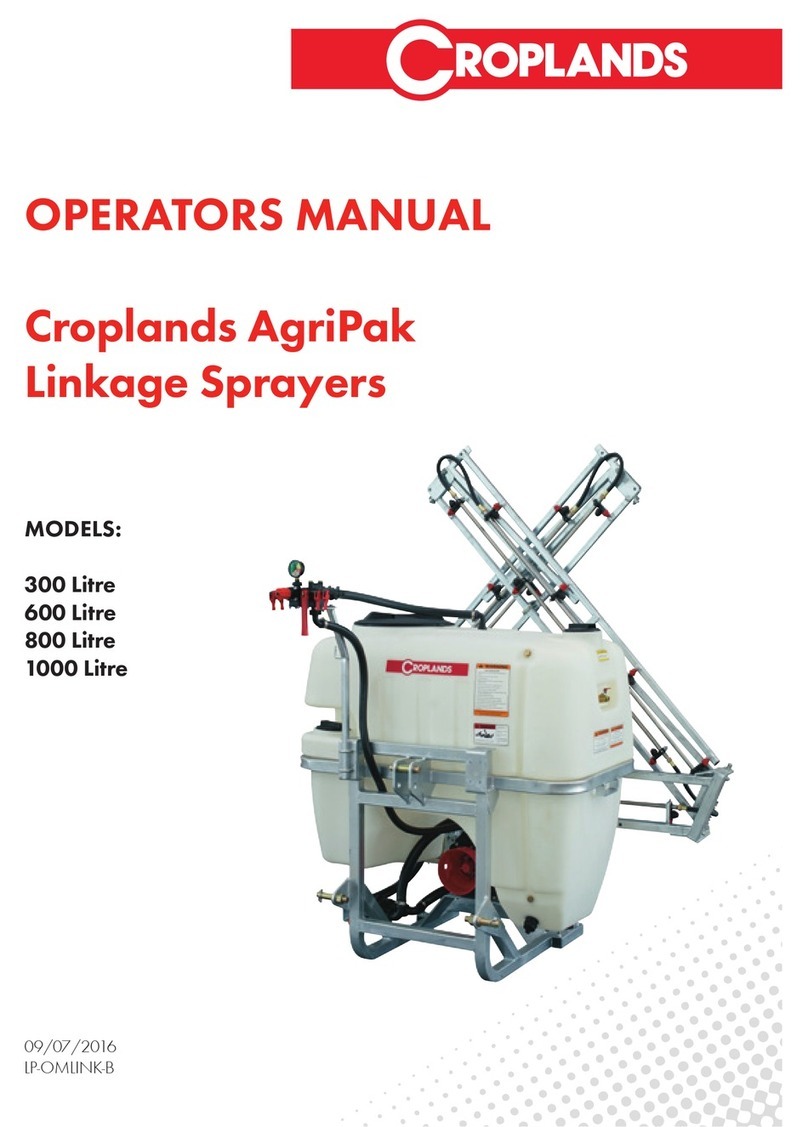
Croplands
Croplands AgriPak LA300 User manual
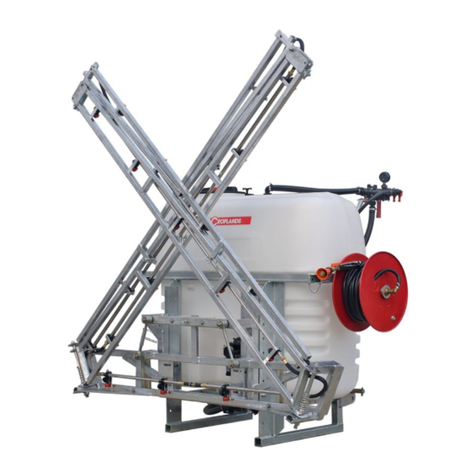
Croplands
Croplands GEX Series User manual
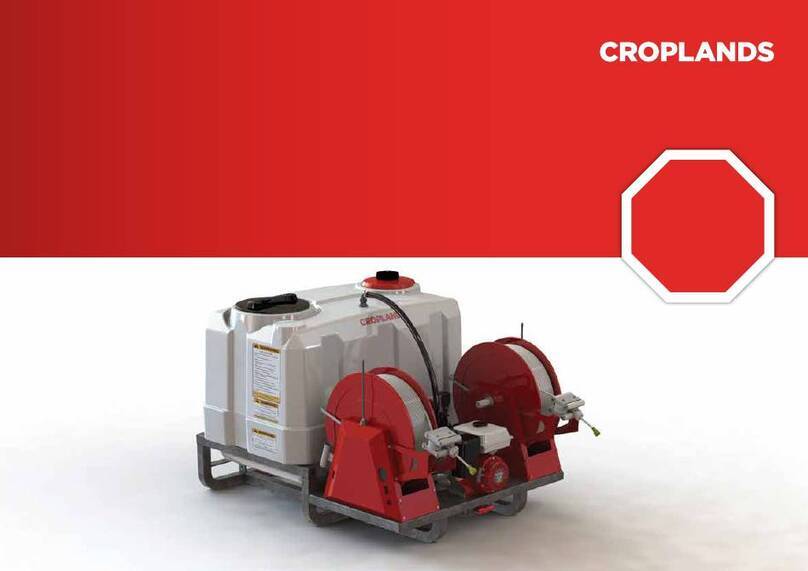
Croplands
Croplands RSRL3-100RC REEL User manual
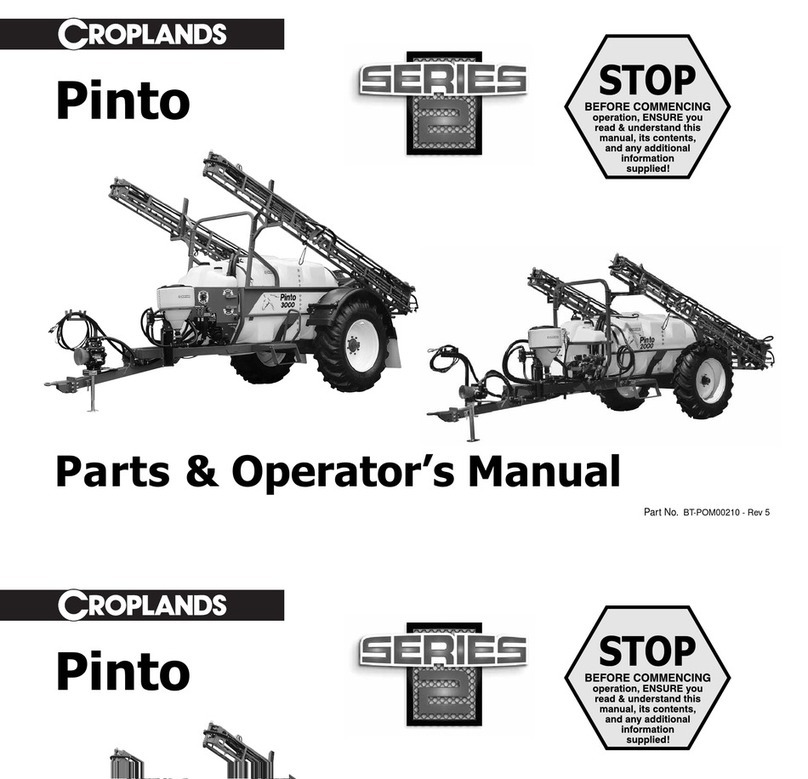
Croplands
Croplands Pinto 2000 User manual
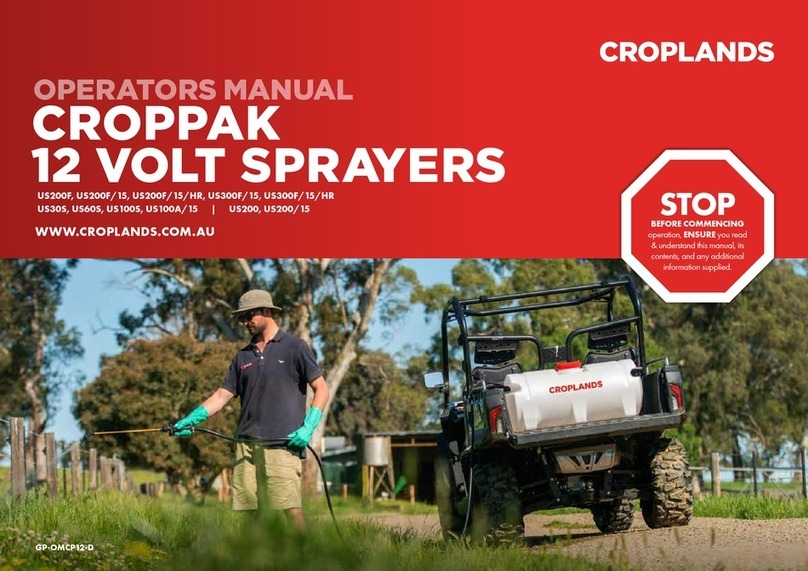
Croplands
Croplands CROPPAK US200F User manual
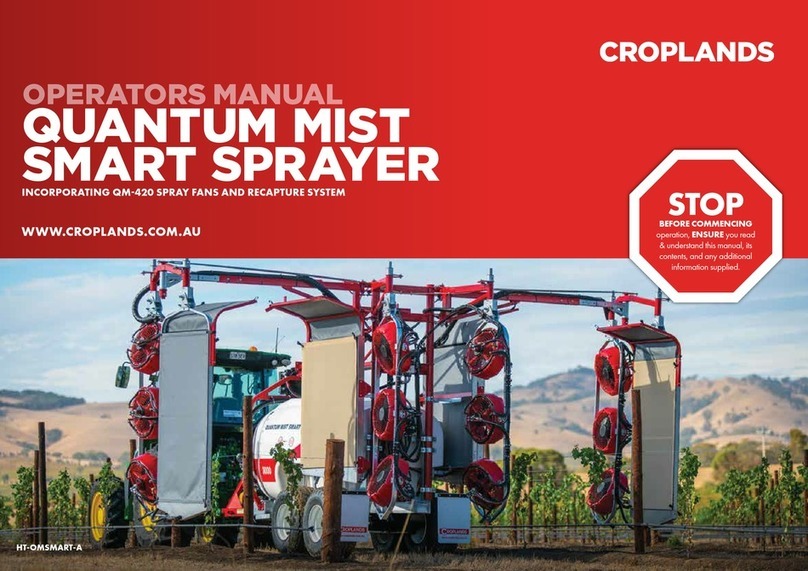
Croplands
Croplands Quantum Mist Smart Spray QM-420 User manual
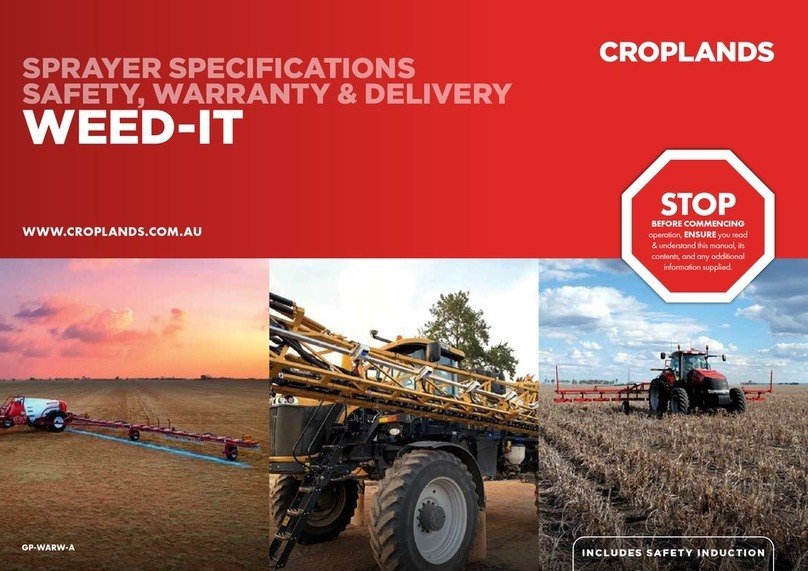
Croplands
Croplands WEED-IT User manual
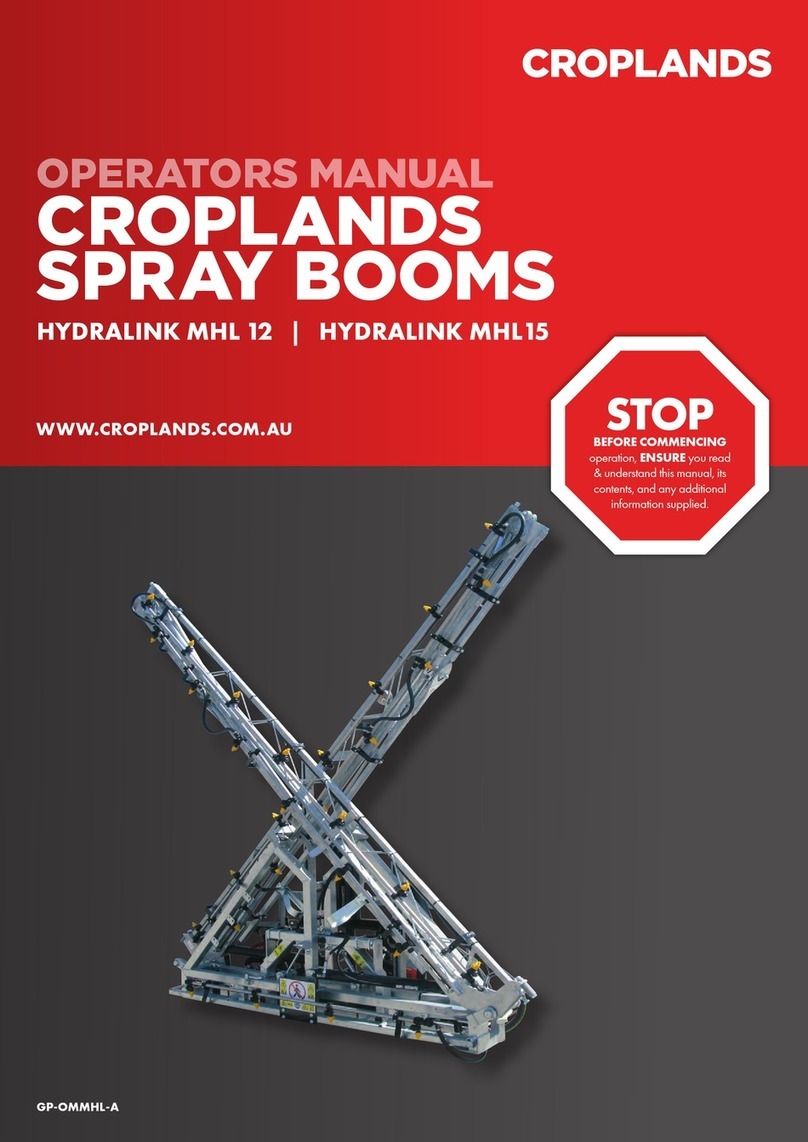
Croplands
Croplands MHL12 User manual
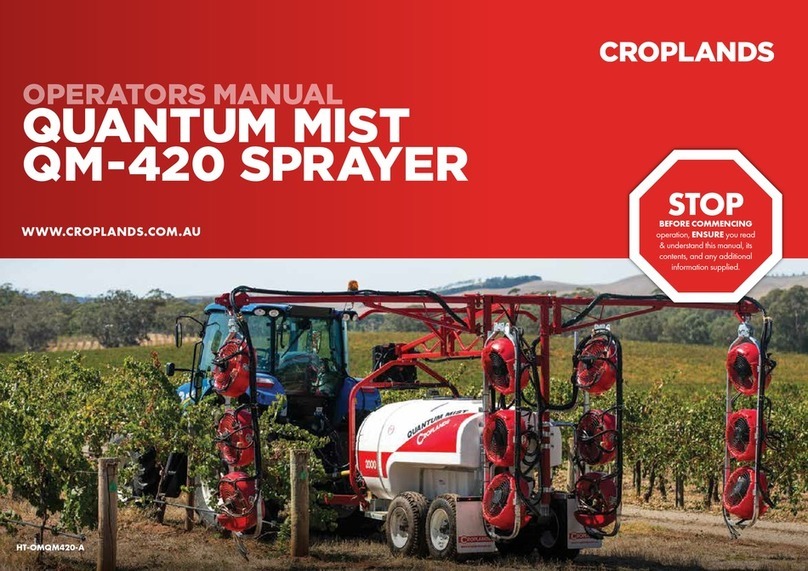
Croplands
Croplands Quantum Mist Smart Spray QM-420 User manual

